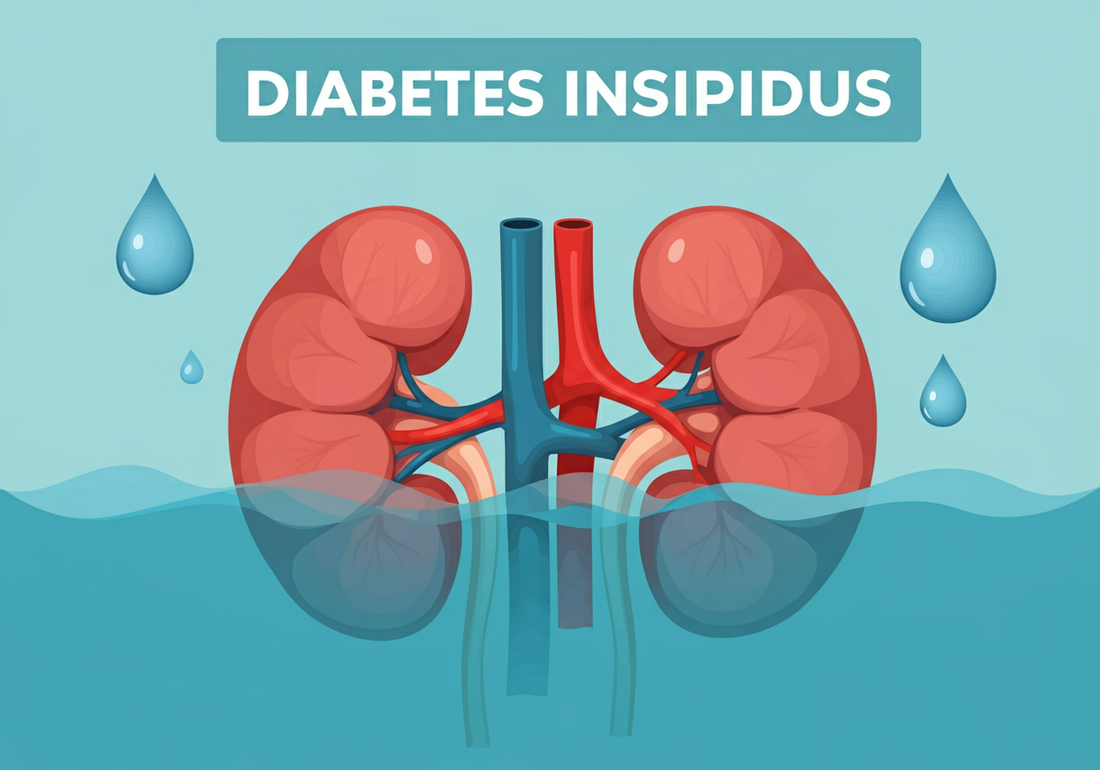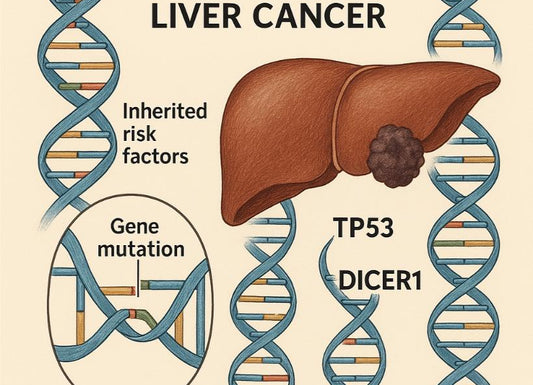Diabetes Insipidus Treatment
 Written By
Abel Tamirat, MD
Written By
Abel Tamirat, MD

If you have been told you might have diabetes insipidus, it is natural to feel concerned. The condition is rare, and its name often leads people to confuse it with diabetes mellitus. But while diabetes mellitus affects blood sugar, diabetes insipidus is about how your body controls fluids.
The good news is that effective treatment options exist. With the right diagnosis and care plan, you can manage symptoms, stay hydrated, and prevent complications. This guide explains what diabetes insipidus is, how it is diagnosed, the treatment options for different types, and the lifestyle steps that can help you feel better.
What is diabetes insipidus?
Diabetes insipidus (DI) is a condition where your body cannot properly balance fluids. Normally, the pituitary gland and hypothalamus in the brain work together to make a hormone called antidiuretic hormone (ADH), also known as vasopressin. This hormone tells your kidneys to hold onto water when your body needs it.
If there is too little ADH, or if your kidneys do not respond to it, your body releases too much water through urine. The result is frequent urination and constant thirst.
Learn how to check your liver health at home with the at-home liver tests guide.
What are the main types of diabetes insipidus?
There are four main types of DI, each with different causes and treatment approaches:
-
Central diabetes insipidus: The brain does not make enough ADH, usually because of damage to the pituitary gland or hypothalamus.
-
Nephrogenic diabetes insipidus: The kidneys do not respond to ADH, even if the hormone is present.
-
Dipsogenic diabetes insipidus: A problem in the brain’s thirst center leads to drinking too much water.
-
Gestational diabetes insipidus: Occurs only during pregnancy when the placenta produces an enzyme that breaks down ADH.
Knowing which type you have is essential for choosing the right treatment.
Because diabetes insipidus affects fluid balance and the kidneys, see the kidney function test at home guide.
What are the symptoms of diabetes insipidus?

The signs can be subtle at first but become clearer over time. Common symptoms include:
-
Excessive urination, often clear or very diluted
-
Constant thirst and craving for cold water
-
Waking up frequently at night to urinate
-
Dehydration, which can cause fatigue, dizziness, or confusion
-
Dry skin or lips
In children, it may also cause bed-wetting, irritability, or delayed growth.
Urinary health is an important part of managing symptoms, and our UTI tests guide explains how to identify and monitor infections.
How is diabetes insipidus diagnosed?
Because frequent urination can be caused by many conditions, your doctor will use specific tests to confirm DI and identify its type.
Water deprivation test
You stop drinking fluids for several hours. During this time, your doctor measures your body weight, urine output, and how concentrated your urine and blood are. Sometimes, you may receive a small dose of synthetic ADH to see if your kidneys respond.
Urine test
A urine sample is checked to see if it contains too much water. In DI, urine is usually very diluted.
Blood tests
Your doctor checks levels of sodium, potassium, calcium, and other electrolytes. These results can help identify the type of DI.
MRI scan
An MRI of the brain looks at the pituitary gland and hypothalamus for problems such as injury, tumors, or abnormalities.
Genetic testing
If DI appears in childhood or runs in families, genetic testing may be suggested.
Together, these tests give a clear picture of what is happening in your body.
Since electrolyte and glucose balance matter in DI, review understanding high glucose in urine.
How is diabetes insipidus treated?
Treatment depends on the type of DI you have. The goal is to reduce symptoms, prevent dehydration, and restore balance.
Central diabetes insipidus treatment
-
Desmopressin: A synthetic version of ADH that replaces what your body cannot make. It comes as a pill, nasal spray, or injection.
-
Dose adjustments: Because your body may still make some ADH, the dose you need can change. Too much desmopressin can cause water retention and low sodium levels.
-
Treat the cause: If DI is linked to a tumor, infection, or injury, addressing that problem may improve hormone levels.
Nephrogenic diabetes insipidus treatment
-
Diet changes: A low-salt diet helps reduce urine output. Sometimes limiting protein also helps.
-
Thiazide diuretics: Although they normally increase urine, in DI they lower urine volume.
-
NSAIDs such as indomethacin: May reduce urine output in some people.
-
Stop harmful medicines: Lithium and certain other drugs can cause DI. Stopping them may reverse symptoms (only under medical guidance).
Dipsogenic diabetes insipidus treatment
-
No medicine works reliably. Instead, the focus is on limiting fluid intake and addressing any related brain or mental health conditions.
Gestational diabetes insipidus treatment
-
Treated with desmopressin, which is considered safe during pregnancy. The condition usually resolves after delivery.
For at-home tracking, the Ribbon Checkup urine test can help monitor hydration and kidney-related markers.
What if diabetes insipidus is mild?
Some cases are mild and do not need medication. Drinking more water may be enough to prevent dehydration. But most people benefit from a structured plan that combines medicine and lifestyle changes.
What lifestyle steps can help?

Daily habits are a powerful part of managing DI:
-
Stay hydrated: Carry a water bottle and drink whenever you are thirsty.
-
Plan ahead: Take extra fluids and medicine when traveling or exercising.
-
Wear a medical alert bracelet: This helps healthcare providers give the right care in emergencies.
-
Monitor your urine output: Keep track of changes so you can adjust treatment quickly.
-
Work with your doctor: Regular checkups ensure your treatment plan stays safe and effective.
What complications can happen if DI is untreated?
Without proper care, DI can lead to:
-
Severe dehydration
-
Low blood pressure
-
Confusion or irritability
-
Seizures in extreme cases
-
Electrolyte imbalances such as low sodium
-
Kidney damage
With treatment, these risks are usually preventable.
What should you expect at your doctor’s appointment?

You may first see your primary doctor and then be referred to an endocrinologist.
How to prepare
-
Ask if you need to limit fluids before your visit.
-
Write down your symptoms, including how often you urinate.
-
Bring a list of medications and medical history.
-
Note any recent head injuries.
-
Prepare questions about diagnosis, treatment, and lifestyle.
-
Bring a family member for support if possible.
Questions to ask your doctor
-
What type of diabetes insipidus do I have?
-
What treatments are available for me?
-
How will we know if treatment is working?
-
Do I need lifestyle or diet changes?
-
How often should I be monitored?
Being prepared helps you get the most from your visit.
How is diabetes insipidus monitored over time?
Even after starting treatment, follow-up is important. Your doctor may check:
-
Blood sodium and potassium levels
-
Kidney function
-
Blood pressure
-
Weight changes
These tests make sure your treatment remains safe and effective.
Key takeaway
Diabetes insipidus is rare but treatable. Treatment depends on the type you have but often includes desmopressin, diet adjustments, or other medicines. With regular monitoring and simple lifestyle steps, most people manage DI well and avoid serious complications.
Managing hydration starts with understanding your body’s balance. Try the Ribbon Checkup urine Test for simple, accurate at-home monitoring.
References
- Flynn, K., et al. (2025). Central and nephrogenic diabetes insipidus: Updates on diagnosis and management. Frontiers in Endocrinology. https://www.frontiersin.org/journals/endocrinology/articles/10.3389/fendo.2024.1479764/full
- Mutter, C. M., Smith, T., Menze, O., Zakharia, M., & Nguyen, H. (2021). Diabetes insipidus: Pathogenesis, diagnosis, and clinical management. PMC. https://pmc.ncbi.nlm.nih.gov/articles/PMC7996474/
- “Diagnosis and management of central diabetes insipidus.” (2022). Journal of Clinical Endocrinology & Metabolism. https://academic.oup.com/jcem/article-abstract/107/10/2701/6623615
- Hui, C., et al. (2024). Arginine vasopressin disorder (diabetes insipidus). In NCBI Bookshelf. https://www.ncbi.nlm.nih.gov/books/NBK470458/
- Tomkins, M., et al. (2022). Diagnosis and management of central diabetes insipidus. PMC. https://pmc.ncbi.nlm.nih.gov/articles/PMC9516129/
- Garrahy, A. (2020). Management of central diabetes insipidus. ScienceDirect. https://www.sciencedirect.com/science/article/abs/pii/S1521690X20300129
- NHS. (n.d.). Diabetes insipidus — Treatment. NHS. https://www.nhs.uk/conditions/diabetes-insipidus/treatment/
- Duicu, C., et al. (2021). Nephrogenic diabetes insipidus in children (review). Experimental and Therapeutic Medicine. https://www.spandidos-publications.com/10.3892/etm.2021.10178
- “Clinical practice guidelines: Diabetes insipidus.” (n.d.). Royal Children’s Hospital Clinical Guide. https://www.rch.org.au/clinicalguide/guideline_index/diabetes_insipidus/
- Randall, R. V. (1961). Treatment of chronic diabetes insipidus. The Journal of Applied Physiology. https://www.tandfonline.com/doi/abs/10.1080/00325481.1961.11692342

Dr. Abel Tamirat is a licensed General Practitioner and ECFMG-certified international medical graduate with over three years of experience supporting U.S.-based telehealth and primary care practices. As a freelance medical writer and Virtual Clinical Support Specialist, he blends frontline clinical expertise with a passion for health technology and evidence-based content. He is also a contributor to Continuing Medical Education (CME) programs.



